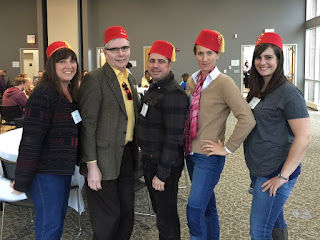This month we have a very special guest author - or rather 5 guest authors! Since January 2016 is the first SLATE Group fully online meeting, we turned to the new SLATE Community Fellows for their expertise in hosting a web meeting. You can "meet" the fellows virtually on January 20, 2016 from 10:00 a.m. - 12:00 p.m. as they host the session about Best Practices in Hosting a Web Meeting.
 |
| SLATE Community Fellows Left to Right: Cheryl, Mike, Brad, Jenifer, and Sarah |
Who are the SLATE Community Fellows?
This month is the first entirely online SLATE monthly meeting, hosted by the inaugural group of SLATE Community Fellows. The SLATE Community Fellows (SCF) are a group of SLATE members who have been involved with the organization and the field of educational technology for a number of years and can serve as resources for the larger SLATE community. The Fellows will not have all the answers, but it is very likely that they will know how to find them.SCF Mission
The mission of the SCF is to engage SLATE members by aggregating and disseminating information on a broad variety of academic technology topics informed by best practices and experience.Annual Theme
The Fellows decided to adopt an annual theme to guide their work within the SLATE organization. This year the theme is Create, Connect, Collaborate. Within this theme, we aim to connect and engage the SLATE membership, and initiate conversations around best practice.Meet the Fellows
- Cheryl Boncuore - @cherylbonc || LinkedIn
Lake Forest Graduate School of Management - Dean of Faculty and Degree Programs - Sarah Fornero @SarahFornero || LinkedIn
Adler University - Director of Design and Delivery, Department of Online Education - Brad Katz - LinkedIn
Illinois Institute of Technology - Associate Director, Instructional Design and Technology - Mike Sukowski @MikeFacDev || LinkedIn
Chicago State University - Director, Center for Teaching and Research Excellence - Jenifer Viencek Murphy LinkedIn
Northwestern College - Director of Distance Education
Best Practices in Hosting a Web Meeting
In conjunction with our theme, the SCF are hosting the January session focused on hosting web meetings on any platform or tool. As we continue the move into the 21st century, more and more institutions depend on web meetings to teach courses and run daily business. Whether holding your face-to-face course remotely while attending an out-of-town conference or convening a synchronous session for your online course, the use of web meetings is relevant for all constituents. However, many individuals are still hesitant to host or participate in a web meeting or are unsure of how to leverage the functionality and tools for an optimal meeting.- Like the Girl Scout or Scar’s motto “Be Prepared”
- Avail yourself of any institution-provided training available, else make friends with Lynda.com, or worst case, YouTube for tutorials and tips
- Work with your tech team/ITS to troubleshoot potential connection/audio/feedback issues
- Practice with colleagues in your new ‘room’ to test functionality and navigation, particularly if you are a beginner
- Provide the opportunity for participants to download software, test their set-up, and familiarize themselves with the application (as appropriate) in a lower stakes test session
- Start with the basics and amp up the bells and whistles as you become more comfortable leading the ship
- Use an external headset with a microphone. Most often an external headset will work better than the built-in microphone and speakers, and reduce feedback
- Use a wired internet connection if possible, because wired is typically more reliable than a wireless one. Wireless still works, but often free wifi at the coffee shop may not be enough to support a full-blown meeting
- Before you start your meeting, consider the following:
- Will this be a 1-way (single speaker) or 2-way (group collaborative) session? This will affect which tools you will need and how you will structure the meeting
- What content do you wish to cover? Think through what you are trying to share and present ahead of time and practice the deliver
- What are a few questions/prompts you might use/integrate? Just like any other presentation/meeting, prepare your outline ahead of time especially with the added component of technology and setup
Thank you to the SLATE Community Fellows for sharing their tips on hosting a web meeting! I am really looking forward to their hosting the first-ever online meeting of the SLATE group, given their obvious expertise.
Are you interested in or have experience with one of the upcoming topics for the monthly SLATE meetings? Want to write a guest post on our blog to share what you have learned about it? Email Stephanie Richter with your proposal to be considered for a guest post!
Are you interested in or have experience with one of the upcoming topics for the monthly SLATE meetings? Want to write a guest post on our blog to share what you have learned about it? Email Stephanie Richter with your proposal to be considered for a guest post!

1 comment:
I have to search sites with relevant information on given topic and provide them to teacher our opinion and the article. 10gbps streaming servers
Post a Comment